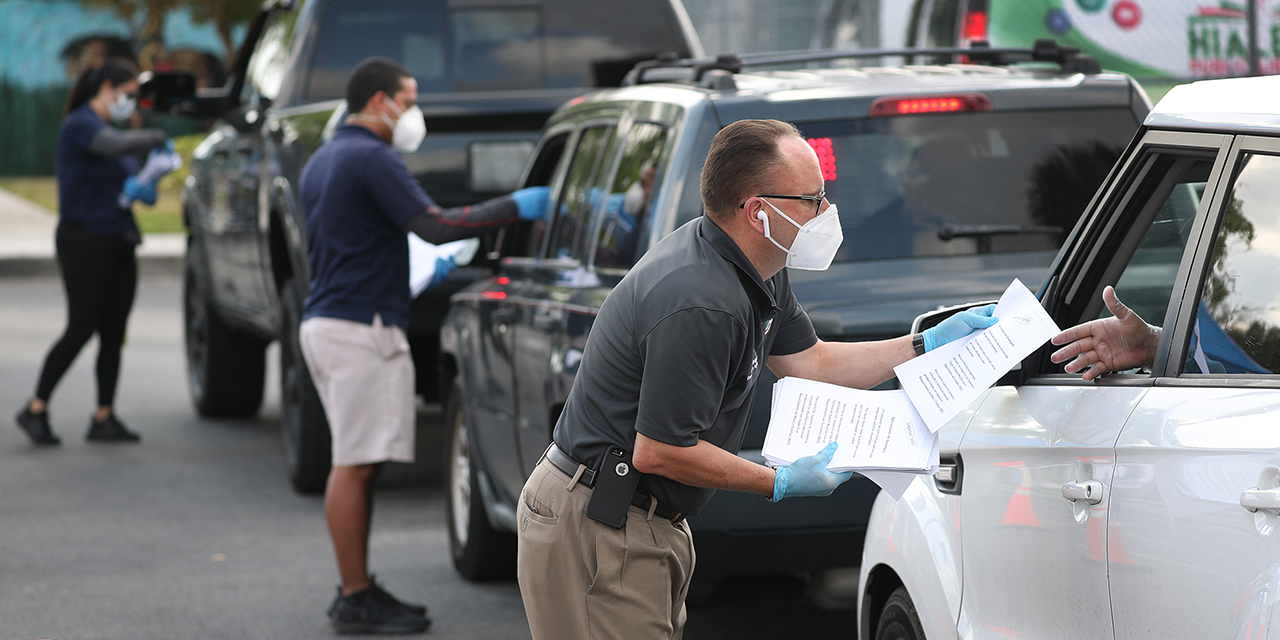
The COVID-19 outbreak and the economic downturn it engendered swelled the ranks of unemployed Americans by more than 14 million, from 6.2 million in February to 20.5 million in May 2020. As a result, the U.S. unemployment rate shot up from 3.8% in February – among the lowest on record in the post-World War II era – to 13.0% in May. That rate was the era’s second highest, trailing only the level reached in April (14.4%).
The rise in the number of unemployed workers due to COVID-19 is substantially greater than the increase due to the Great Recession, when the number unemployed increased by 8.8 million from the end of 2007 to the beginning of 2010. The Great Recession, which officially lasted from December 2007 to June 2009, pushed the unemployment rate to a peak of 10.6% in January 2010, considerably less than the rate currently, according to a new Pew Research Center analysis of government data.
The COVID-19 recession, barely three months old, has had a sharp and severe impact on unemployment among American workers. This report focuses on how the recession has affected unemployment among major demographic groups of workers. The key indicator analyzed is the unemployment rate, which is the number of workers actively seeking work – the unemployed – as a share of workers either at work or actively seeking work – the labor force.
Most estimates of the unemployment rate in this report are from the U.S. Bureau of Labor Statistics, based on its survey of households, the Current Population Survey (CPS). The CPS is the government’s official source for monthly estimates of unemployment. Additional estimates, specifically those for racial, ethnic and nativity groups in the Great Recession, are based on the analysis of CPS data by Pew Research Center. Most estimates for the Great Recession period are adjusted to account for the effects of annual revisions to the CPS. All estimates are nonseasonally adjusted because seasonal adjustment factors are not available for many of the demographic groups included in this report.
The COVID-19 outbreak has affected data collection efforts by the U.S. government in its surveys, especially limiting in-person data collection. This resulted in about a 10 percentage point decrease in the response rate for the CPS in March and April 2020 and an even greater decrease in May 2020. It is possible that some measures of unemployment and its demographic composition are affected by these changes in data collection.
The unemployment rate in May might have been as high as 16%, by the U.S. government’s estimate. But it is not recorded as such because of measurement challenges that have arisen amid the coronavirus outbreak. Also, a sharp decline in labor force participation among U.S. workers overall may be adding to the understatement of unemployment. In May, 9 million Americans not in the labor force were in want of a job compared with 5 million in February, per government estimates. But these workers are not included in the official measure of unemployment. Thus, the COVID-19 recession is comparable more to the Great Depression of the 1930s, when the unemployment rate is estimated to have reached 25%.
Unemployment among all groups of workers increased sharply in the COVID-19 recession. But the experiences of several groups of workers, such as women and black men, in the COVID-19 outbreak vary notably from how they experienced the Great Recession. Here are five facts about how the COVID-19 downturn is affecting unemployment among American workers.
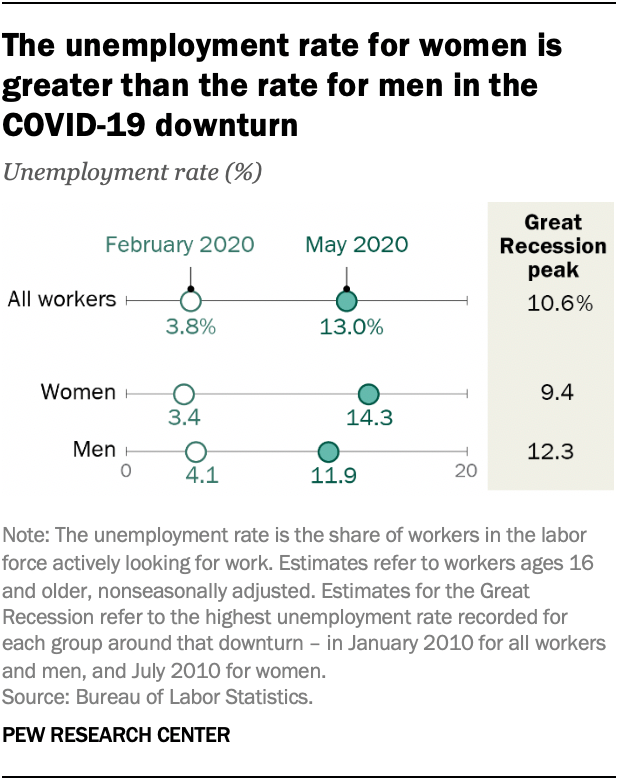 1The unemployment rate for women in May (14.3%) was higher than the unemployment rate for men (11.9%). This stands in contrast to the Great Recession, when the unemployment rate for women had peaked at 9.4% in July 2010 compared with a peak of 12.3% for men in January 2010.
1The unemployment rate for women in May (14.3%) was higher than the unemployment rate for men (11.9%). This stands in contrast to the Great Recession, when the unemployment rate for women had peaked at 9.4% in July 2010 compared with a peak of 12.3% for men in January 2010.
One reason women have seen a greater rise in unemployment in the current downturn is that they accounted for the majority of workers on the payrolls of businesses in the leisure and hospitality sector and educational services sector in February. Employment in these two sectors fell by 39% and 15% from February to May, respectively, leading most other sectors by a wide margin. By contrast, job losses in the Great Recession arose primarily from the construction and manufacturing sectors, where women have a much lighter footprint than men.
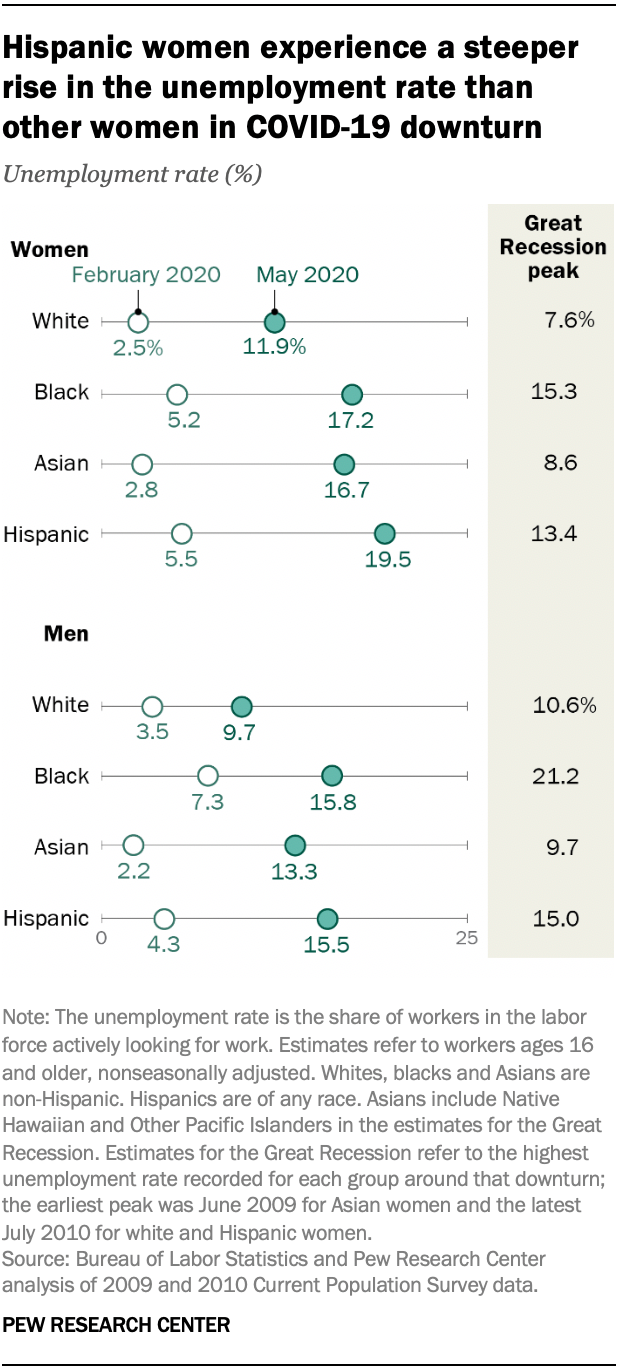 2The unemployment rate for black men in May (15.8%) was substantially less than the peak rate they faced in the Great Recession (21.2%). Black men are the only group among those examined in this analysis for whom such a notable gap exists. The reasons for this are not entirely clear but are likely rooted in the occupation and industry distributions of black men. Recessions in which the turmoil is centered in goods-producing sectors, such as the Great Recession, appear to take a greater toll on the job prospects of black men. The unemployment rate for black men previously topped 20% in the twin recessions of the early 1980s, when manufacturing employment also took a sharp dive.
2The unemployment rate for black men in May (15.8%) was substantially less than the peak rate they faced in the Great Recession (21.2%). Black men are the only group among those examined in this analysis for whom such a notable gap exists. The reasons for this are not entirely clear but are likely rooted in the occupation and industry distributions of black men. Recessions in which the turmoil is centered in goods-producing sectors, such as the Great Recession, appear to take a greater toll on the job prospects of black men. The unemployment rate for black men previously topped 20% in the twin recessions of the early 1980s, when manufacturing employment also took a sharp dive.
Among other men, Hispanic workers faced an unemployment rate of 15.5% in May, higher than the rates for Asian (13.3%) and white (9.7%) men. While the unemployment rates for Asian and white men increased sharply in the COVID-19 recession, they remain below the rates for black and Hispanic men.
Hispanic women had the highest rate of unemployment in May (19.5%), compared with other women or men among the nation’s major racial and ethnic groups. The unemployment rate among white women jumped nearly fivefold, climbing from 2.5% in February to 11.9% in May. A steep increase in the unemployment rate among Asian women also pushed their unemployment rate in May (16.7%) to near parity with the unemployment rate among black women (17.2%). The recent experience of white and Asian women stands in contrast to their experience in the Great Recession, when their unemployment rates peaked at levels substantially below the levels reached for black and Hispanic women.
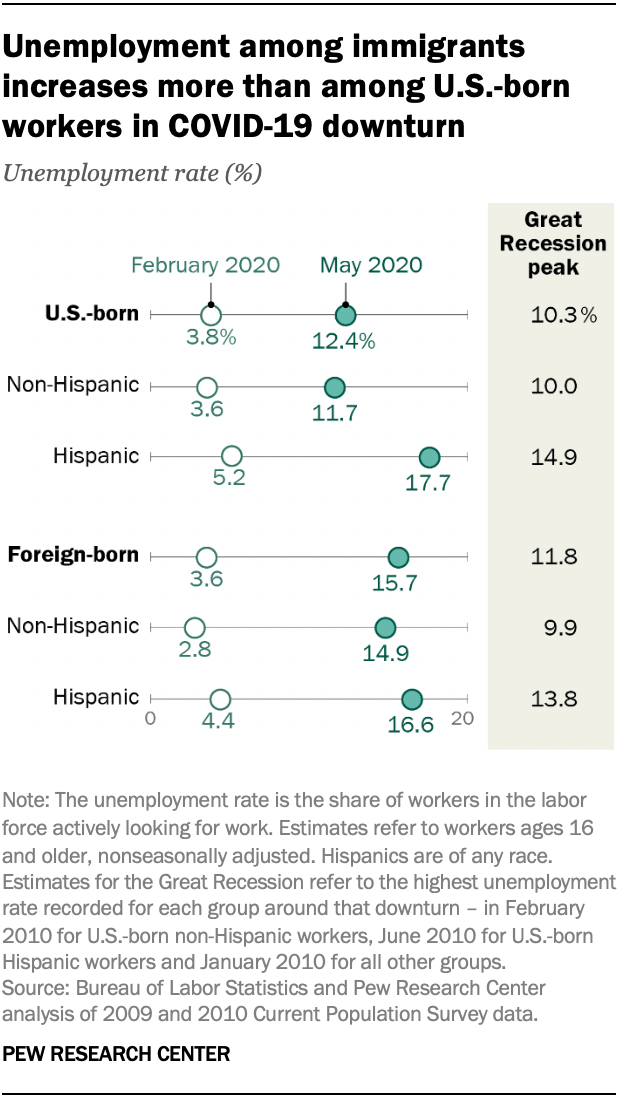 3Immigrants saw their unemployment rate jump higher than the rate for U.S.-born workers in the COVID-19 downturn, mirroring their experience in the Great Recession. In February, immigrants and U.S.-born workers had similarly low rates of unemployment, 3.6% and 3.8%, respectively. By May, the unemployment rate for immigrants had risen to 15.7%, compared with 12.4% for U.S.-born workers.
3Immigrants saw their unemployment rate jump higher than the rate for U.S.-born workers in the COVID-19 downturn, mirroring their experience in the Great Recession. In February, immigrants and U.S.-born workers had similarly low rates of unemployment, 3.6% and 3.8%, respectively. By May, the unemployment rate for immigrants had risen to 15.7%, compared with 12.4% for U.S.-born workers.
The steeper increase in the unemployment rate for immigrants is driven by the experience of Hispanic workers who comprised 47% of the immigrant workforce in February, compared with 12% of the U.S.-born workforce. Compared with non-Hispanic workers, Hispanic workers are relatively young and are less likely to have graduated from college. Additionally, 44% of Hispanic immigrants in the labor force are estimated to have been unauthorized in 2016. These characteristics of Hispanic workers make them more vulnerable to job losses in economic downturns.
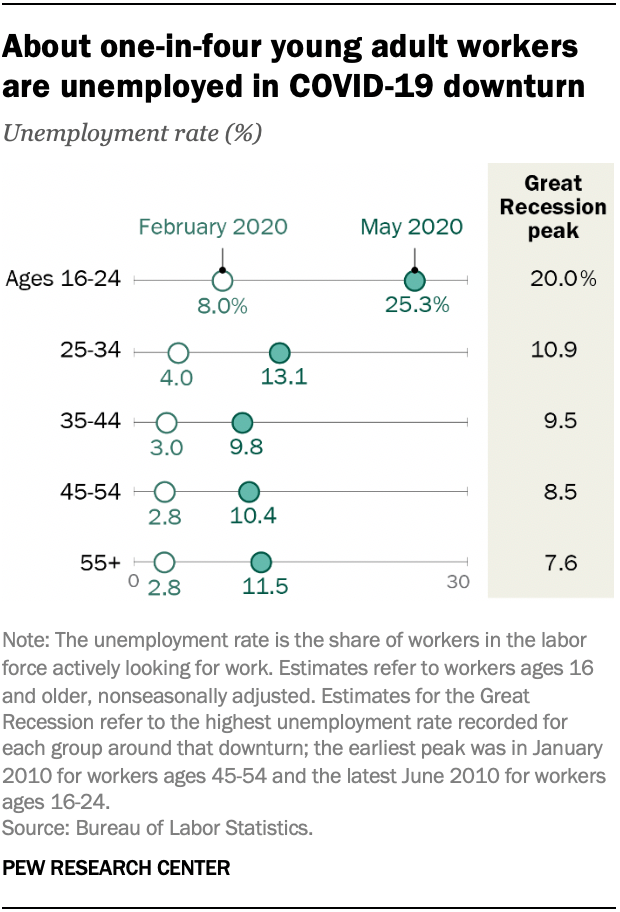 4Workers in all but one age group saw their unemployment rate climb into the double digits in May due to the COVID-19 outbreak, unlike the Great Recession when this was true only for younger workers. The unemployment rate among young adults ages 16 to 24 (25.3%) exceeded the rate among other workers by a substantial margin in May, more than double the rate among workers 35 and older. A key reason is the concentration of young adults in higher-risk industries, such as food services and drinking places, that were more affected by the need for social distancing and government mandated shutdowns.
4Workers in all but one age group saw their unemployment rate climb into the double digits in May due to the COVID-19 outbreak, unlike the Great Recession when this was true only for younger workers. The unemployment rate among young adults ages 16 to 24 (25.3%) exceeded the rate among other workers by a substantial margin in May, more than double the rate among workers 35 and older. A key reason is the concentration of young adults in higher-risk industries, such as food services and drinking places, that were more affected by the need for social distancing and government mandated shutdowns.
Changes in the unemployment rate by age in the COVID-19 recession are consistent with patterns in past recessions. During the Great Recession the unemployment rate for young adults peaked at 20% in June 2010, compared with no greater than 10.9% among older workers.
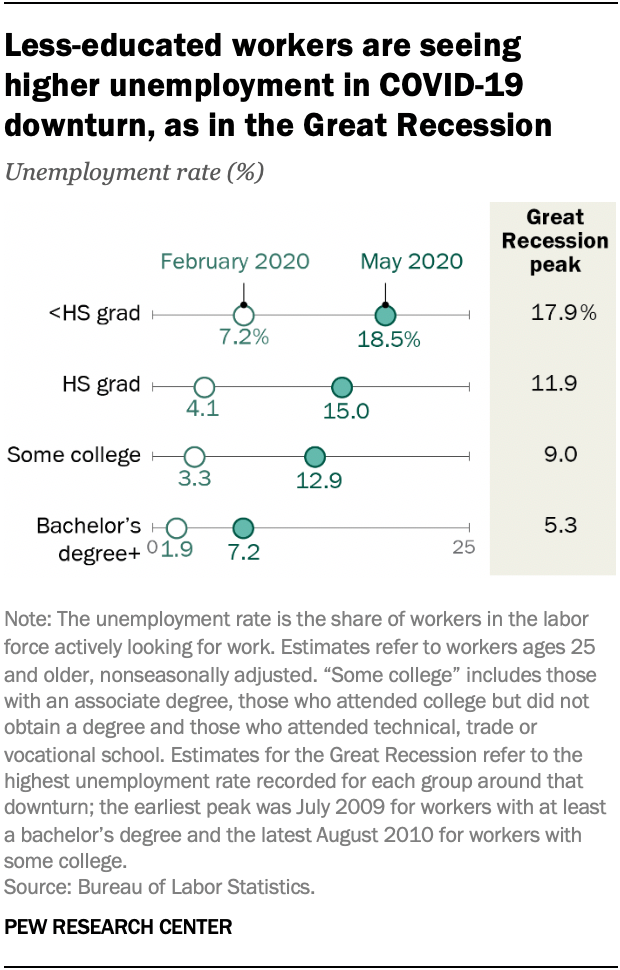 5Unemployment rates in the COVID-19 downturn are lower among workers with higher levels of education, as in the Great Recession. The unemployment rate in May was lowest among workers with a bachelor’s degree or higher education (7.2%), the only group among those examined not to experience an unemployment rate in the double digits. In contrast, 18.5% of workers without a high school diploma were unemployed in May. In the Great Recession, the peak unemployment rates for the different groups ranged from 5.3% among those with a bachelor’s degree or higher education to 17.9% among those without a high school diploma.
5Unemployment rates in the COVID-19 downturn are lower among workers with higher levels of education, as in the Great Recession. The unemployment rate in May was lowest among workers with a bachelor’s degree or higher education (7.2%), the only group among those examined not to experience an unemployment rate in the double digits. In contrast, 18.5% of workers without a high school diploma were unemployed in May. In the Great Recession, the peak unemployment rates for the different groups ranged from 5.3% among those with a bachelor’s degree or higher education to 17.9% among those without a high school diploma.
A unique factor in the COVID-19 recession is the significance of teleworking in keeping people on the job. The option to telework varied considerably across workers in February depending on their education level, with those with a college degree six times as likely to have the option as those without a high school diploma, 62% vs. 9%. Nonetheless, the May unemployment rate among college graduates was nearly four times that of February.
[callout]Read the other posts in this series:
- Hispanic women, immigrants, young adults, those with less education hit hardest by COVID-19 job losses
- Unemployment rate is higher than officially recorded, more so for women and certain other groups



